|
113. Issoria lathonia (Linnaeus, 1758) / Queen of Spain fritillary / Nymphalidae –Heliconiinae
NL: kleine parelmoervlinder / D: Kleiner Perlmutterfalter / F: petit nacré
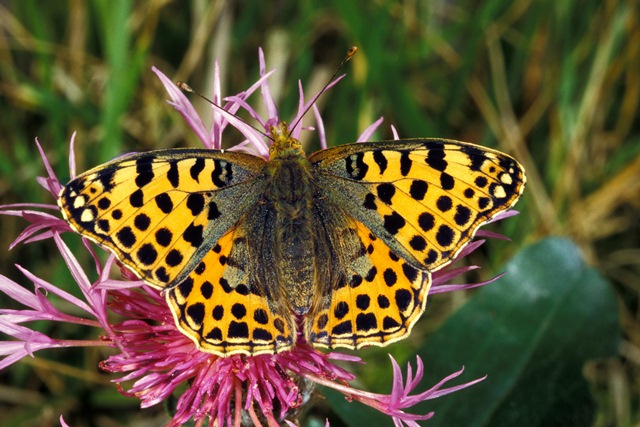 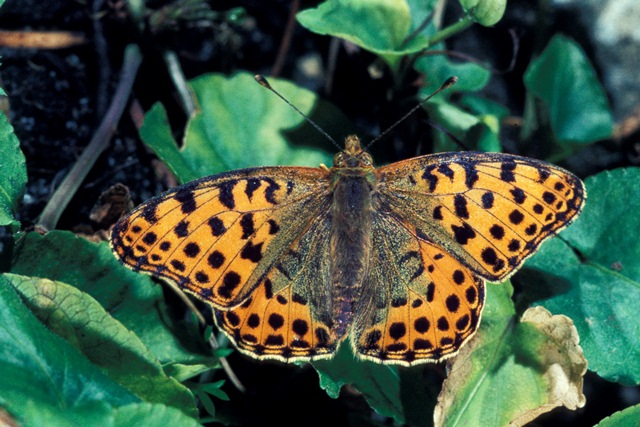 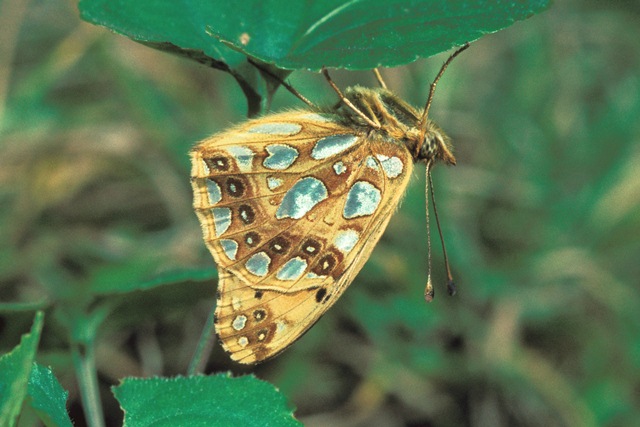
Photographs: Frits Bink ©.
Medium-sized, wing length 21 (19-23) mm. The species is known from all countries of the Benelux, in Luxemburg and Wallonia everywhere on fallow fields and some grasslands on loam and chalk soil, in Flanders and the Netherlands in the coastal dunes and in some years also inland.
Butterfly is on the wing from end-April until end-September and peaks in August. The species is known from maritime and continental climates, amplitude 7 to 17. Required heat sum 600°d and maximum tolerated 3000°d, corresponding climate windows are 22 weeks and whole year open.
A curious fact is that this species in England occurs only as a rare immigrant, occasionally establishing transient colonies, whereas in the Dutch coastal dunes it is an omnipresent species. In the maritime climate it is a typical dune species making use of the variety in microclimate correlated by the warm south and cool north slopes of the dunes to survive the unpredictability of the maritime climate.
Ecological characteristics
Behaviour over time
Overwintering: small or half grown larva in third, fourth or exceptionally fifth instar in the litter layer.
Reproduction: oviposition start after 5-11 days when the body contains 120 (103-140) eggs, estimated potential production 3 times as much.
Larval feeding periods: feeding larvae are present from early-March until end-October.
Generations: depending on summer warmth two up to four.
Spreading of risk: flexibility in spatial behaviour of the adult and in larval growth.
Life cycle: egg 6 (4-9) days; larvae fast growing in summer 19 (13-30) days and slow growing in winter 24-36 weeks; pupa 12 (8-15) days.
Life span of adult: rather long, 3 weeks.
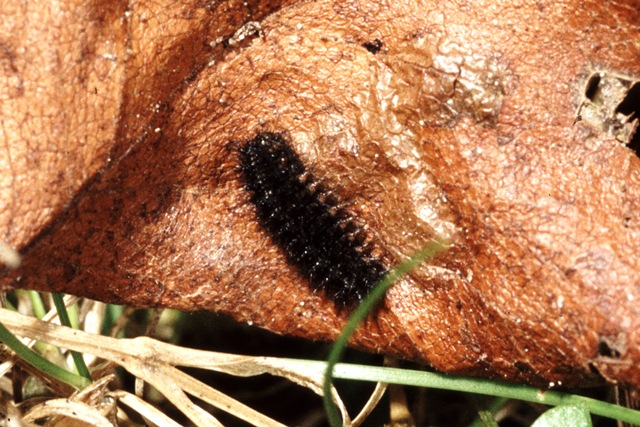 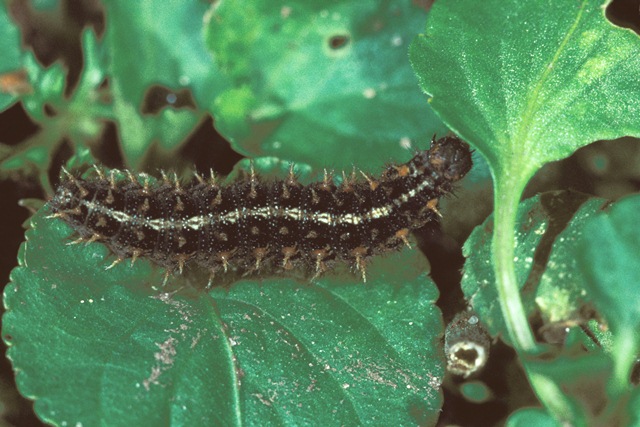
Photographs: Frits Bink ©.
Behaviour in space
From stay-at-home to migrant: nomad, spatial requirement considerable.
Finding a mate: male patrols.
Orientation in the landscape: open landscape with short vegetation.
Oviposition: individually on the leaves of the host.
Defence
Threats from other organisms: larva is armoured with soft spines and the pupa resembles a bird dropping and is in a tent.
Threats from the environment: larva and adult resist heat and drought quite well.
Feeding habits
Adult: nectar, all kind of flowers such as yellow composites and flowering privet.
Larva: wanders around to look for a new violet, larvae do not devour the plant instantly.
Larval foodplants
Plant species: Violaceae, Viola arvensis, V. canina, V. curtisii, V. rupestris, V. tricolor.
Journal
Rearing experiments:
1. Based on specimen from Walbach, Vosges, France:
7 September 1981: female captured.
After the eggs hatched many newly born larvae refused to eat Viola canina, whereas Viola tricolor was accepted immediately. Larvae divided into 2 groups: a) placed under artificial light with 18 hour day-length and at 28°C ambient temperature; b) under natural conditions.
Series a):
18 October: biggest larva 22 mm in length.
26 October: three already pupated, larvae constructed a tent to pupate.
9 November: first adult appeared, male.
20 November: last pupa hatched.
Series b):
18 October: biggest larvae 8 mm in length.
26 October: biggest larvae 11 mm in length.
Overwintered in fridge.
11 February 1982: larvae taken out of the fridge.
14 February: larvae basked but did not eat.
21 February: one larva moulted, larvae ate very fast.
26 March: pupa hatched, male.
2. Based on specimen from Dieue-sur-Meuse, Lorraine, France:
5 September 1984: female captured.
9 September: 120 eggs laid.
18 September: first eggs hatched.
29 September: larvae in moult L2-3, basked on wilted leaf. Viola canina was refused as food but V. tricolor was accepted.
Larvae divided into 2 groups: a) placed under artificial light with 18 hour day-length and at 28°C ambient temperature; b) under natural conditions.
Series a):
16 October: first prepupa.
19 October: first pupa.
1 November: first adult appeared.
Series b):
16 October: larvae in third instar but not yet in diapause.
19 October: larvae prepared to hibernate, great spread in size: two in L5, five in L4 and four in L3.
Overwintered outdoors.
February 1985: all larger larvae dead but those in L3 survived.
Table 113-1. Results of dissections

Table 113-2. Collection and observation localities
DK, Aalbeak, 57° 37’ 10”N – 10° 17’ 25”E; 15 June 2004.
DK, Gundersted, 56° 55’ 08”N – 9° 26’ 31”E; 10 July 2005.
DK, Lundby, 56° 55’46”N – 9° 29’ 43”E; 8 July 2005.
F, Dommartin-la-Montagne, 49° 01’ 51”N – 5° 36’ 53”E; 24 June 2006.
F, Montmédy, 217 m, 49° 31’ 07”N – 5° 21’ 33” E; 19 August 1984.
F, Lorraine, Dieue-sur-Meuse, 250 m, 49° 04’ 30”N – 5° 26’ 34”E; 12 June 1984, 5 September 1984, 10 July 1985.
F, Vosges, Grand Ballon, 1424 m, 47° 54’ 04”N – 7° 05’ 54”E; 26 July 1983.
F, Vosges, Walbach, 350 m, 48° 04’ 12”N – 7° 12’ 44”E; 7 September 1981.
F, Vosges, le Zinnkoepfle, 481 m, 47° 57’ 56”N – 7° 15’ 08”E; 3 September 1981, 10 July 1984, 22 August 1984.
NL, Bakkum, 52° 33’ 13”N – 4° 37’ 58”E; 4 June 1985.
NL, Castricum, 52° 33’ 07”N – 4° 37’ 43”E; 23 June 1998.
NL, Terschelling, 53° 24’ 32”N – 6° 19’ 38”E; 16 April 1991.
NL, Texel, 53° 01’ 15”N – 4° 43’ 39”E; 8 June 1980, 11 July 1983, 26 June 1995, 22 April 2008.
NL, Zandvoort, 58° 22’ 00”N – 4° 32’ 14”E; 16 June 2002.
S, Gotland, Lickershamn, 57° 50’ 17”N – 18° 34’ 54”E; 3 July 2004.
S, Öland, Frösslunda, 56° 32’ 34”N – 16° 35’ 12”E; 22 July 2004.
S, Öland, Stenåsa, 56° 32’ 44”N – 16° 36’ 43”E; 21 July 2004.
Fig. 113-1. Issoria lathonia, phenogram adapted from Bos et al. 2006: 305.
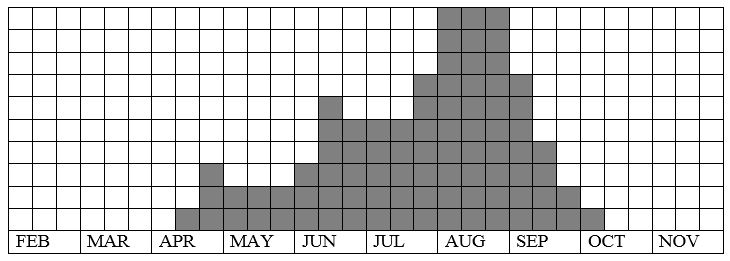
Fig. 113-2. Issoria lathonia, habitat characteristics.
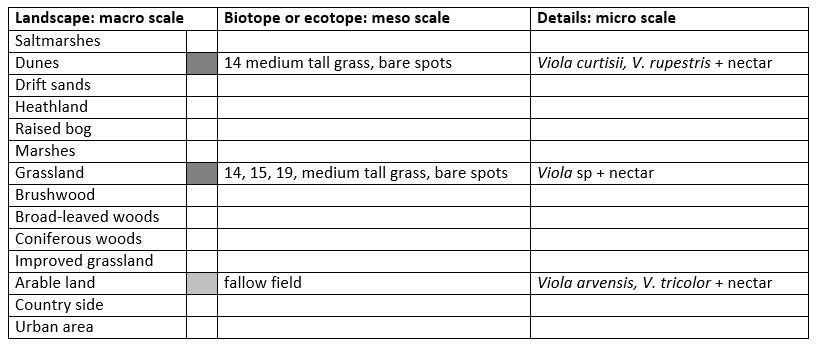
Fig. 113-3. Issoria lathonia, climate matrix, heat-sums 600 - 3000°d.
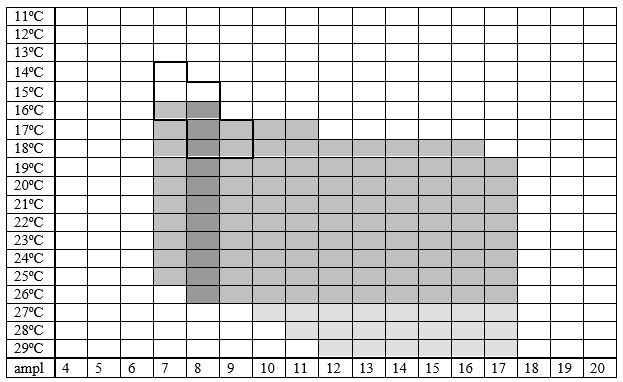
|










